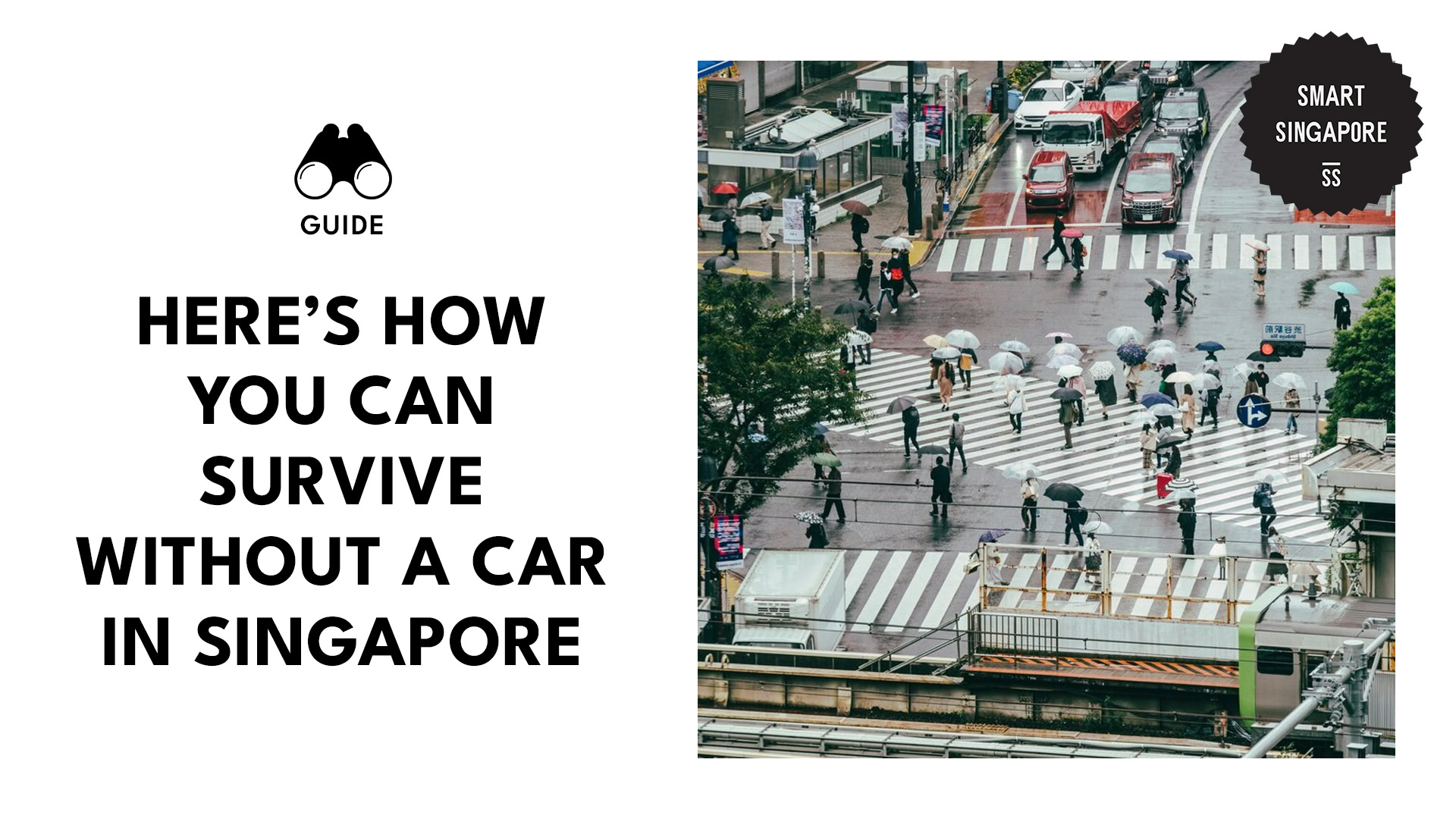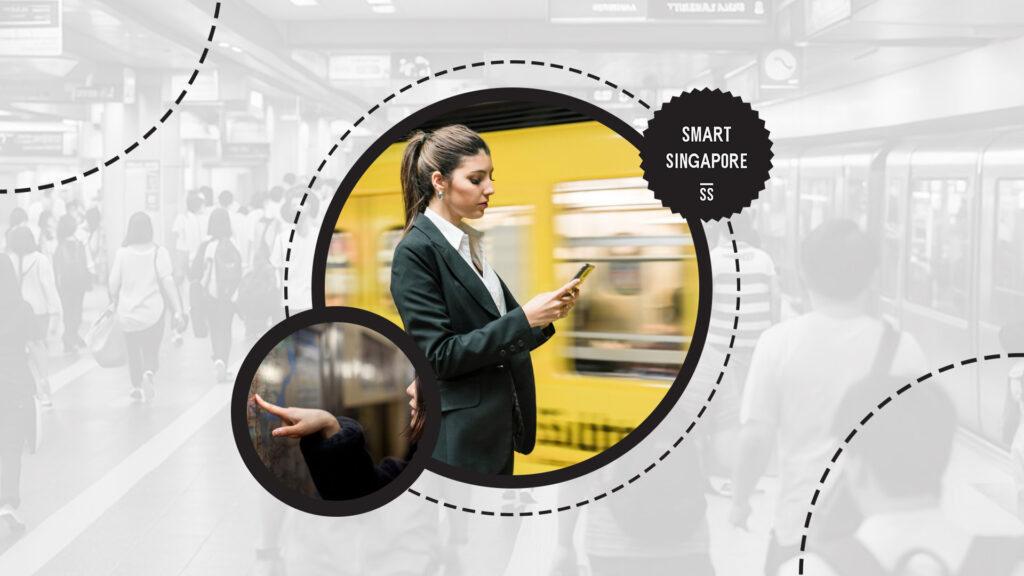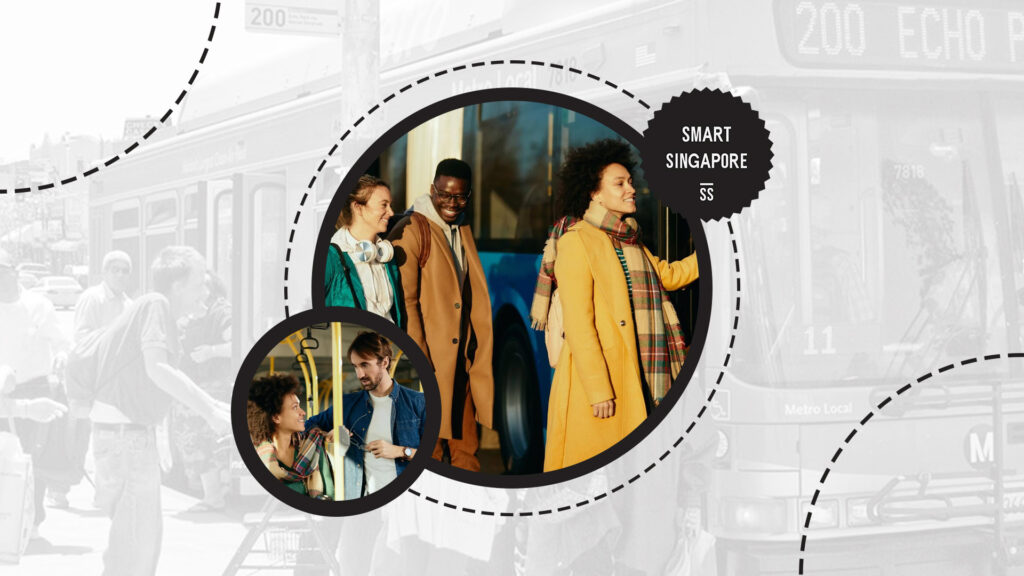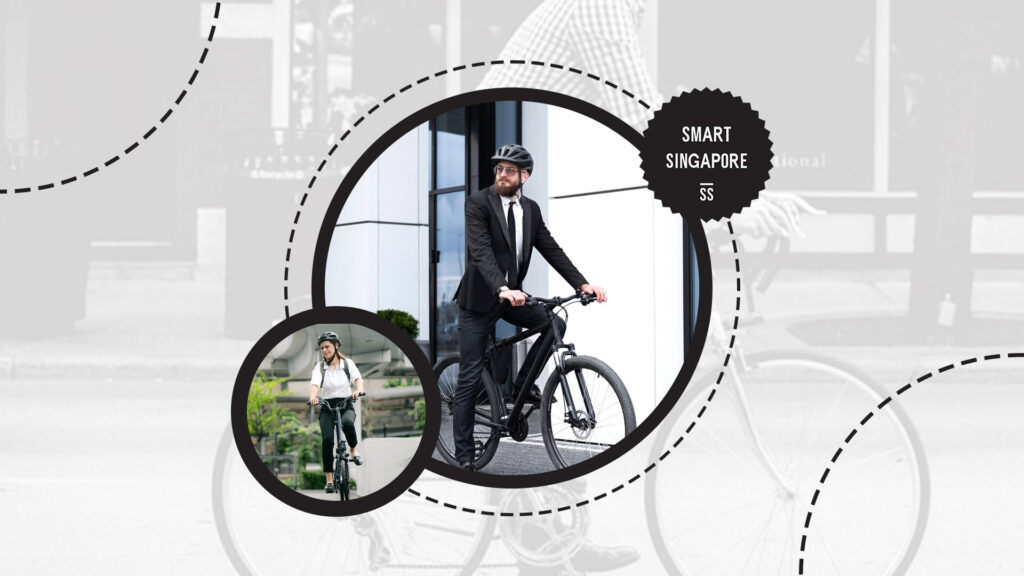Categories > Guides and Tips

Here’s how you can survive without a car in Singapore (and always be on time!)
Can you live without a car in Singapore? Absolutely! I’ve been doing it for years, and honestly, it’s quite convenient and cost-effective, thanks to our reliable public transportation network.
If you’re like me and contemplating a car-free lifestyle in the Lion City, allow me to share several useful tips. With this guide, you’ll learn to get around the island in a breeze without needing to buy a car.
What are the alternatives to owning a car in Singapore?
MRT

Getting around Singapore by MRT is super easy and efficient, which is why both locals and visitors love it. The MRT network is extensive, with several lines that connect all the key areas across the island, from residential neighbourhoods and business districts to popular attractions.
Here’s a quick guide on how to navigate the MRT system and some useful tips.
✔ Understand the MRT lines – Singapore’s MRT system comprises several lines, each designated by a different colour. Key lines include the North-South Line (red), East-West Line (green), North-East Line (purple), Circle Line (orange), and Downtown Line (blue).
Each line intersects at various interchange stations, allowing for easy transfers between lines.
✔ Buy and use tickets – You can purchase single-trip tickets at ticketing machines located in MRT stations, but for convenience, consider getting an EZ-Link card or a Singapore Tourist Pass.
These stored-value cards can be topped up and used for multiple trips, providing seamless access to the MRT and bus services.
✔ Plan your journey – Use apps like SG MRT or Citymapper, or refer to the official MRT system map available at all stations to plan your route. These tools provide real-time updates, estimated travel times, and route suggestions.
✔ Know peak hours – The MRT can get crowded during peak hours (7 AM – 9 AM and 5 PM – 7 PM on weekdays). If possible, try to travel outside these times for a more comfortable journey.
✔ Use accessibility tools – All MRT stations are equipped with lifts, escalators, and ramps, making them accessible for passengers with disabilities, the elderly, and those with strollers.
✔ Practise etiquette and safety – Stand on the left side of escalators, giving way to those in a hurry on the right. Allow passengers to alight before boarding, and always stand behind the yellow line while waiting for the train.
Eating and drinking are not allowed within the stations and trains.
✔ Get familiar with the first and last trains – MRT services typically start around 5.30 AM and end around midnight. Be sure to check the timing of the first and last trains on the specific lines you plan to use, especially if you have early or late travel plans.
Public Buses

Getting around Singapore by public buses is another great option, complementing the MRT system and offering extensive coverage across the island. Here’s a quick guide on navigating the bus system and some useful tips.
✔ Understand bus routes – Singapore’s bus network is extensive, with routes covering almost every part of the island. Bus stops have route maps and information boards displaying the bus numbers and their destinations.
Don’t worry about being stranded because popular routes, with frequent buses, are well-serviced.
✔ Buy and use tickets – Like the MRT, you can use an EZ-Link card or Singapore Tourist Pass for bus rides. Just tap your card on the reader when you board and alight.
Cash payments are also accepted, but it’s less convenient and often requires exact change.
✔ Plan your journey – Use apps like MyTransport.SG, Bus@SG, or Google Maps to plan your bus routes. These apps provide real-time updates on bus arrivals, route information, and estimated travel times.
✔ Travel outside peak hours – During peak hours (7 AM – 9 AM and 5 PM – 7 PM), buses can get crowded, so try to travel outside these times if you prefer a less busy experience.
✔ Practise bus etiquette – Always queue up at the bus stop and let passengers alight before boarding. Seats are often reserved for the elderly, pregnant women, and people with disabilities, so be mindful and offer your seat when necessary.
✔ Use night bus services – For late-night travel, NightRider or NiteOwl buses operate on Fridays, Saturdays, and the eves of public holidays, providing service until the early hours. There are also express bus services for faster travel along popular routes.
✔ Know bus stops and interchanges – Bus stops are conveniently located and clearly marked. Major bus interchanges are usually connected to MRT stations, making transfers between buses and trains seamless.
✔ Use accessibility tools – Buses are equipped with features to assist passengers with disabilities, including ramps and designated spaces for wheelchairs. They are also generally well-maintained, air-conditioned, and comfortable.
✔ Get help – If you’re unsure about which bus to take, don’t hesitate to ask friendly bus captains or fellow passengers for help. Singaporeans are generally helpful and willing to assist.
Taxis and Ride-Hailing Services

Getting around Singapore via taxis and ride-sharing services is incredibly convenient, providing flexible and direct transportation options. Here’s how to navigate these services and some useful tips.
Taxis
✔ Know availability – Taxis are widely available in Singapore and can be hailed on the street, booked via phone, or found at taxi stands located at shopping malls, hotels, and major attractions.
✔ Use booking apps – Use apps like ComfortDelGro, Grab, or Gojek to book taxis. With them, you can track time, pay without cash, and get estimated fares in a few clicks.
✔ Understand fare structure – Taxi fares in Singapore are metered, with additional surcharges during peak hours, late-night rides, and trips to/from Changi Airport. Look out for electronic fare metres that display the total fare at the end of the journey.
✔ Choose payment options – Most taxis accept cash, credit/debit cards, and mobile payments. Always check with the driver if you prefer a specific payment method.
✔ Practise safety and etiquette – Singapore taxis are generally safe and reliable. It’s customary to fasten your seatbelt and ensure you have small bills for cash payments. Tipping is not expected but appreciated for excellent service.
Ride-Sharing Services
✔ Use ride-sharing apps – Grab and Gojek are the leading ride-sharing services in Singapore. Download their apps to book rides easily. These apps offer various ride options, from budget to premium services.
✔ Book a ride – Simply enter your pick-up and drop-off locations in the app, choose your preferred ride option, and confirm the booking. The app will show the driver’s details, estimated arrival time, and fare upfront.
✔ Opt for shared rides – For a cheaper option, consider shared rides like GrabShare, where you share the ride with other passengers heading in the same direction. It’s cost-effective but might take slightly longer due to additional stops.
✔ Use promos and discounts – Keep an eye out for promotional codes and discounts offered by ride-sharing apps. These can help you save money, especially during non-peak hours.
✔ Know safety features – Both Grab and Gojek offer safety features such as real-time tracking, emergency contact sharing, and 24/7 customer support. Always verify the driver’s identity and vehicle details before starting your ride.
✔ Be aware of surge pricing – Be aware of peak hours when demand is high, as ride fares may increase due to surge pricing. Plan your trips accordingly or consider alternative transport during these times.
✔ Use special services – Grab and Gojek offer additional services like GrabFamily for rides with child safety seats, GrabAssist for passengers with mobility needs, and Gojek’s GoCar XL for larger groups.
Cycling and Bike-Sharing

Cycling and bike-sharing provide a flexible and sustainable way to navigate Singapore. With a well-developed infrastructure and easy access to shared bikes, it’s a fantastic option for both short trips and leisurely rides, helping you stay active and reduce your carbon footprint.
Cycling
✔ Know popular cycling routes – Singapore has lots of bike-friendly infrastructure. Some popular routes include the East Coast Park, Marina Bay, and the Park Connector Network (PCN), which connects various parks and green spaces across the island.
These routes are scenic and well-maintained, perfect for leisure rides or commutes.
✔ Practise cycling safety – Always wear a helmet and adhere to traffic rules. Use hand signals to indicate your intentions to other road users, and be cautious at junctions and pedestrian crossings.
Equip your bike with front and rear lights if you’re cycling at night.
✔ Park your bike properly – Use designated bike parking areas or racks available at most MRT stations, parks, and public spaces. Avoid parking in non-designated areas to prevent fines or your bike being impounded.
✔ Join cycling groups – Join local cycling groups or communities like LoveCyclingSG or the Singapore Cycling Federation. These groups often organise rides, provide tips, and offer a great way to meet fellow cyclists.
Bike-Sharing
✔ Use bike-sharing apps – Download bike-sharing apps like Anywheel and SG Bike to access shared bicycles across the city. These apps allow you to locate, unlock, and pay for bike rentals easily using your smartphone.
✔ Utilise bike-sharing services – To use a bike-sharing service, simply open the app, locate a nearby bike, scan the QR code to unlock it, and start riding. When you’re done, park the bike at a designated area and lock it via the app.
✔ Understand payment and costs – Bike-sharing services typically charge based on the duration of the ride. Payments can be made via credit/debit cards or mobile payment options linked to the app.
Look out for promotions and discounts to save on rental costs!
✔ Know bike availability – Shared bikes are usually available at MRT stations, parks, and busy neighbourhoods. Use the app to check for bike availability and parking spots in real time.
✔ Maintain the bikes – While bike-sharing services maintain their fleets, it’s always a good idea to check quickly before riding. Ensure the brakes and gears are working, and the tires are properly inflated.
✔ Practise etiquette and courtesy – Be mindful of pedestrians and other cyclists, especially on shared paths. Ring your bell to alert others of your presence, and slow down in crowded areas. Always follow the cycling rules and guidelines set by the Land Transport Authority (LTA).
Car-Sharing

Car sharing in Singapore provides convenient and flexible access to cars without the hassles of ownership or relying on a hired driver. Follow these tips to maximise car-sharing services and enjoy driving in Singapore while minimising costs and responsibilities.
✔ Know car-sharing services – Several car-sharing services operate in Singapore, with the most popular ones being BlueSG, Tribecar, and Shariot. These services offer a range of vehicles that can be rented by the hour or day, providing flexibility for different needs.
✔ Register for membership – To use a car-sharing service, you’ll need to sign up for a membership. This usually involves a registration process where you provide your personal details, driving licence information, and payment method.
Some services may charge a membership fee.
✔ Book a car – Once registered, you can book a car using the service’s app or website. You’ll be able to see available cars in your vicinity, choose the type of vehicle you need, and select your rental duration.
✔ Know pick-up and drop-off locations – Car-sharing vehicles are typically parked at designated locations across the city, such as car parks, residential areas, or near MRT stations.
You pick up the car from the designated spot and return it to the same or another approved location, depending on the service’s policies.
✔ Plan ahead – Book your car in advance, especially during peak hours or weekends, to ensure availability. Check the app for real-time availability and book as early as possible if you have specific timing needs.
✔ Understand pricing – Familiarise yourself with the pricing structure of your chosen car-sharing service. Rates may vary based on the type of vehicle, rental duration, and time of day. Some services also charge additional fees for insurance, fuel, or cleaning.
✔ Practise parking etiquette – Park the car in designated parking spots as per the service’s guidelines. Avoid illegal parking, as fines and penalties will be your responsibility. If you’re using a service that allows flexible drop-off locations, make sure it’s a permitted area.
✔ Refuel as needed – Some car-sharing services require you to refuel the car before returning it, while others include fuel in the rental cost. Check the fuel policy and ensure you return the car with the required fuel level to avoid extra charges.





